
The Cuban tree frog is a large species of tree frog that is native to Cuba, the Bahamas, and the Cayman Islands; but has become invasive in several other places around the Americas. Its wide diet and ability to thrive in urban areas has made it a highly invasive species with established colonies in places such as Florida, the Hawaiian island of Oahu, and the Caribbean Islands. These tree frogs can vary in size from 2 to 5.5 inches in length. Due to their large size, Cuban tree frogs can eat a wide variety of things, particularly native tree frogs, and their removal has shown to result in an increase in the amount of native tree frogs in an area. The tadpoles of Cuban tree frogs also heavily compete with native frog tadpoles, which can cause negative effects in body mass, size at metamorphosis, and growth rates for the native tadpoles.
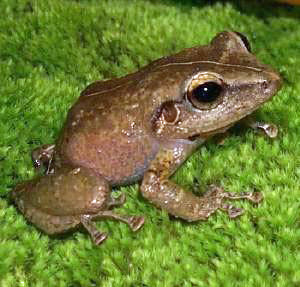
The common coquí, widely known as the coquí, is a species of frog native to Puerto Rico belonging to the family Eleutherodactylidae. The species is named for the loud call the males make at night, which serves two purposes; the "co" serves to repel other males and establish territory while the "quí" serves to attract females. The auditory systems of males and females respond preferentially to different notes of the male call, displaying sex difference in a sensory system. The common coquí is a very important aspect of Puerto Rican culture, and it has become an unofficial territorial symbol of Puerto Rico. The frog is also found elsewhere, and is usually considered an invasive species outside Puerto Rico.

The golden coquí is a rare, possibly extinct species of frog endemic to Puerto Rico.

The web-footed coqui, stream coqui, Puerto Rican stream frog, Karl's robber frog or coquí palmeado, is a possibly extinct Puerto Rican frog species in the family Eleutherodactylidae. It was first described by Chapman Grant in 1931, and was named after herpetologist Karl Patterson Schmidt. It is the largest Eleutherodactylus species of Puerto Rico.

The fauna of Puerto Rico is similar to other island archipelago faunas, with high endemism, and low, skewed taxonomic diversity. Bats are the only extant native terrestrial mammals in Puerto Rico. All other terrestrial mammals in the area were introduced by humans, and include species such as cats, goats, sheep, the small Indian mongoose, and escaped monkeys. Marine mammals include dolphins, manatees, and whales. Of the 349 bird species, about 120 breed in the archipelago, and 47.5% are accidental or rare.
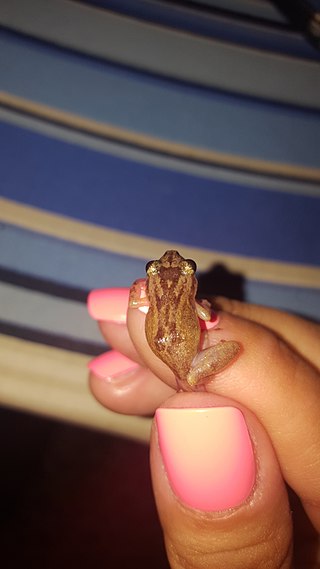
The whistling coquí, coquí pitito, Cochran's treefrog, or Cochran's robber frog is a species of frog native to Puerto Rico, the US Virgin Islands, and the British Virgin Islands. This nocturnal insectivore is also referred to as the coquí pitito in Puerto Rico. Their distinctive song is a single, rising whistle, which is repeated and followed by three clicking sounds.
Coquí is a common name for several species of small frogs in the genus Eleutherodactylus native to Puerto Rico. They are onomatopoeically named for the very loud mating call which the males of two species, the common coqui and the upland coqui, make at night. The coquí is one of the most common frogs in Puerto Rico, with more than 16 different species found within its territory, including 13 in El Yunque National Forest. Other species of this genus can be found in the rest of the Caribbean and elsewhere in the Neotropics, in Central and South America. The coquí is an unofficial national symbol of Puerto Rico; there is a Puerto Rican expression that goes, "Soy de aquí, como el coquí", which translates to "I'm from here, like the coquí."

Eneida's coquí is a species of coquí, a small variety of frog endemic to the main island of Puerto Rico and its archipelago. Known as coquí de Eneida in Puerto Rico, this amphibian is mainly terrestrial. Its average adult size is from 1.0 to 1.2 inches. It has a number of small warts located across its back and eyelids. Its main color is a light tone of greenish or grayish brown with a yellow tint on its underbelly. They often have a pair of light colored concave lines located on their backs. Their eyes are golden or green colored, generally dark colored with black venal reticulation. Its habitat is located in mountains that are 1,000 to 3,000 feet above sea level. This species seems to have suffered a population reduction, in the process disappearing from areas formerly considered its natural habitat. The reason behind this reduction is under study, and Eneida's coquí has been designated an endangered species until the cause is discovered. This population decrease is not considered to be linked with the loss of its habitat, which has prevented the protection of its habitat.

The grass coqui or coqui de las hierbas is a species of frog in the family Eleutherodactylidae, endemic to Puerto Rico. Its natural habitats are subtropical or tropical moist lowland forest, subtropical or tropical moist montane forest, subtropical or tropical seasonally wet or flooded lowland grassland, plantations, rural gardens, and heavily degraded former forest. It is threatened by habitat loss.

The cricket coqui, green coqui, or coquí grillo is a species of frog in the family Eleutherodactylidae endemic to Puerto Rico. Its natural habitats are subtropical or tropical moist lowland forest and subtropical or tropical moist montane forest.

Hedrick's coqui, the treehole coqui, or coqui de Hedrick is a species of frog in the family Eleutherodactylidae endemic to Puerto Rico. Its natural habitats are subtropical or tropical moist lowland forest and subtropical or tropical moist montane forest.

The Antilles coqui, commonly known as the Montserrat whistling frog, Barbados whistling frog, or the Lesser Antillean whistling frog, is a species of frog in the family Eleutherodactylidae found in Bermuda, the Caribbean and northern South America. Its natural habitats are subtropical or tropical moist lowland forest, subtropical or tropical moist montane forest, subtropical or tropical moist shrubland, subtropical or tropical dry lowland grassland, arable land, pastureland, plantations, rural gardens, urban areas, and heavily degraded former forests.
The locust coqui or coquí martillito is a species of frog in the family Eleutherodactylidae endemic to Puerto Rico. Its natural habitats are subtropical or tropical moist lowland forests and subtropical or tropical moist montane forests. E. locustus has suffered a population decline of more than 80% due to introduced predators and amphibian chytrid disease. Scientists believe amphibian chytrid disease may be exacerbated by climate change - warmer temperatures in dry, moist habitats, causing stress that may lead to greater susceptibility to the disease.
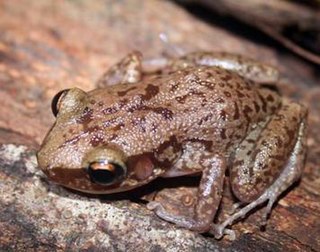
The Mona coqui, coquí de la Mona or coquí de Mona, is a species of frog in the family Eleutherodactylidae endemic to Mona, Puerto Rico. Its natural habitats are subtropical or tropical dry forest and subtropical or tropical dry shrubland.
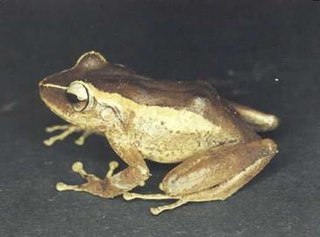
Eleutherodactylus portoricensis is a frog native to Puerto Rico that belongs to the family Eleutherodactylidae. Its vernacular English names are upland coqui, mountain coqui, and Puerto Rican robber frog. The species’ range spans the Luquillo Mountains of northeastern Puerto Rico and the Cordillera Central, which forms the highland “backbone” of Puerto Rico and includes an eastern extension beginning at the city of Cayey. However, the species is likely extirpated from the western Cordillera Central.

The bronze coqui, Richmond's coqui, coquí caoba or coquí de Richmond, is a species of frog in the family Eleutherodactylidae. The specific epithet, richmondi, is dedicated to Dr. Charles W. Richmond.

The dwarf coqui or elfin coqui is a species of frog endemic to Puerto Rico. It is placed in the subgenus Eleutherodactylus.

The melodius coqui or coquí melodioso is a frog species in the family Eleutherodactylidae endemic to Puerto Rico. Its natural habitats are subtropical or tropical moist lowland forest and subtropical or tropical moist montane forest. It is threatened by habitat loss.
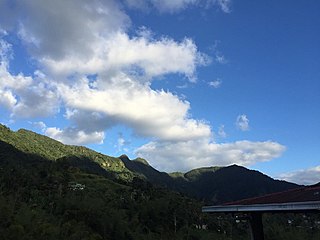
Los Tres Picachos State Forest is one of the 20 forests that make up the public forest system of Puerto Rico. The forest is located in the Central Mountain Range or Cordillera Central, along the Los Tres Picachos mountain ridge, one of the island's highest mountains, named after the distinctive three peaks of the highest mountain in the forest. The state forest is located in the municipalities of Jayuya and Ciales.

San Patricio State Forest, also known as the San Patricio Urban Forest is one of the 20 forests that make up the public forest system of Puerto Rico. This is a secondary or second-growth forest is located in the Gobernador Piñero district of San Juan, between the neighborhoods of Villa Borinquen, Caparra Heights and Borinquen Towers complex. The urban forest has entrances on Roosevelt Avenue and Ensenada Street. The forest extends to almost 70 acres and it is the smallest protected area in the Puerto Rico state forest system. One of the most distinctive features of the forest is the mogote on its northern edge which can be observed from many parts of San Juan and Guaynabo. The forest is part of the Northern Karst.


















